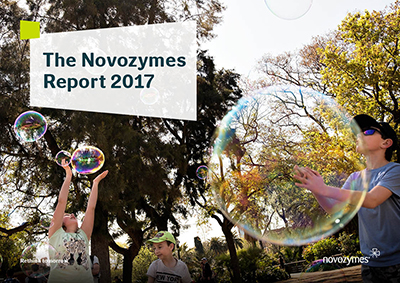Operational ecoefficiency
Novozymes strives to decouple environmental impact from business growth. We have three efficiency/intensity targets that measure performance improvements against the base year 2014. The efficiency/intensity is measured as consumption/emissions divided by gross profit A company’s total revenue (equivalent to total sales) minus the cost of goods sold..
In 2017, absolute energy and water consumption and CO2 emissions increased at a higher rate than gross profit, resulting in reduced performance compared with 2016. This increase in consumption was due to significantly higher capacity utilization at Novozymes’ production sites.
Climate change
Novozymes’ CO2 intensity reduction compared with the base year 2014 fell to 11% in 2017 from 16% in 2016.
Despite this, Novozymes' net overall impact on climate change remains positive, as its products result in lower CO2 emissions over their life cycles compared with conventional technologies. In 2017, our customers avoided an estimated 76 million tons of CO2 emissions by applying our solutions in their products or processes, up from 69 million tons in 2016. This is equivalent to taking 32 million cars off the road.
Energy
In 2017, Novozymes’ energy efficiency improved by 4% compared with the base year 2014, down from 10% in 2016.
Energy consumption from renewable sourcesThe proportion of the energy used at Novozymes’ sites that consists of continuously replenished energy generated from natural processes. Sources include solar, wind and hydro power-based electricity and energy from biogas. remained at 24% in 2017. All our electricity in Denmark and Brazil comes from offshore windfarms and hydropower.
Water
In 2017, Novozymes’ water efficiency declined by 2% compared with the base year 2014, down from a 6% improvement in 2016.
The total volume of wastewater generated in 2017 increased by 15% from 2016. In 2017, we invested significantly to increase wastewater treatment capacity at our largest production site in Kalundborg, Denmark.
Waste
Novozymes recovered 97% of its total solid waste and biomass Organic material, predominantly plants or plant residues. generated in 2017 from landfill, on par with 2016.
Specifically, for solid waste, the rate of recycling across our global production sites decreased to 43%, compared with 44% in 2016.
Environmental compliance
The number of breaches of regulatory limits recorded worldwide declined to 24 in 2017 from 37 in 2016. Most of these breaches relate to wastewater treatment. Novozymes is addressing these incidents.
In addition, we received 12 complaints in 2017, compared with nine in 2016, mostly related to air pollution and waste management.





